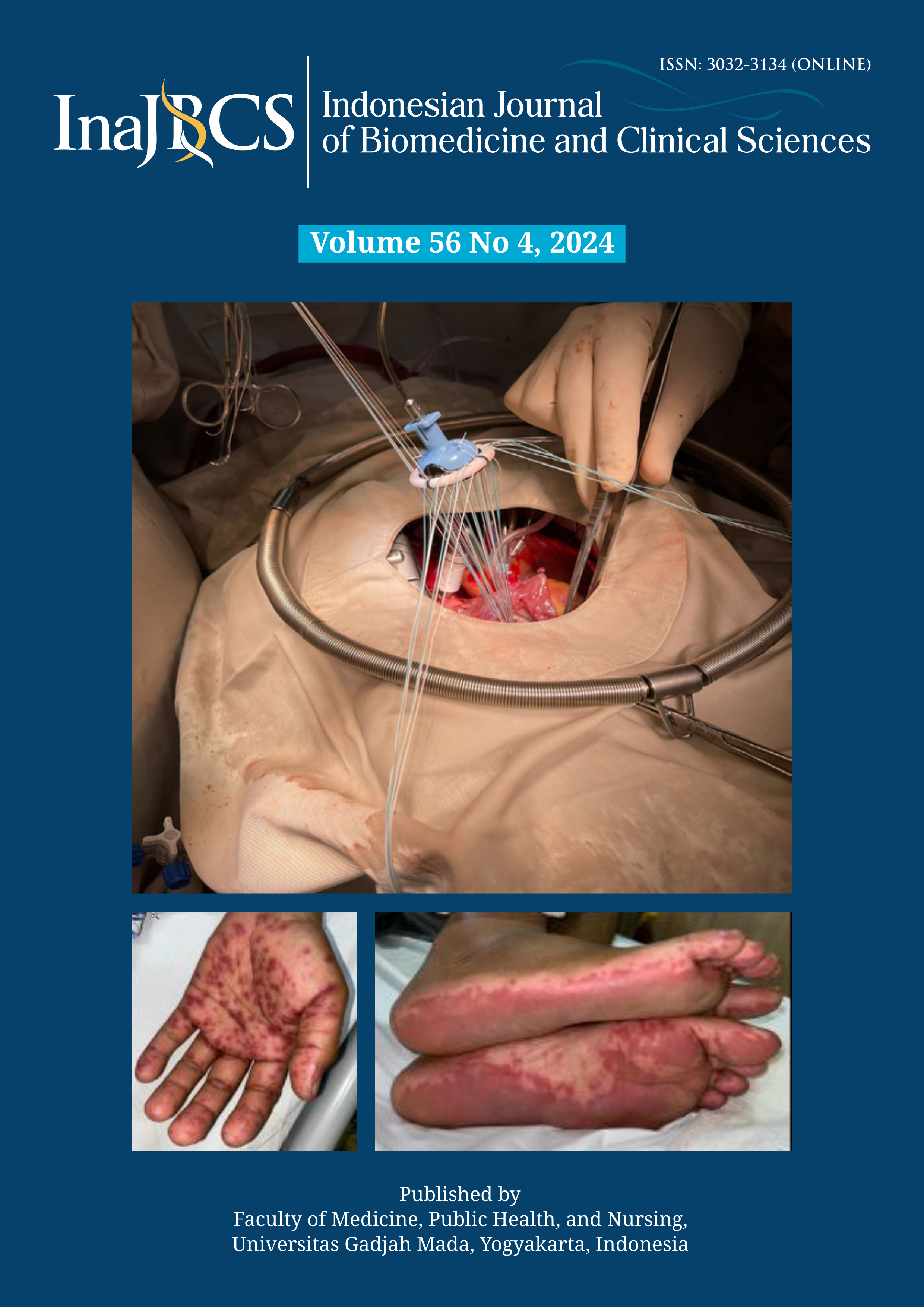Toxoplasma encephalitis in HIV/AIDS patients in Prof. Dr. I.G.N.G. Ngoerah General Hospital, Bali, Indonesia
Abstract
Toxoplasma gondii, an opportunistic infection in HIV/AIDS patients, is an obligate intracellular parasite that causes toxoplasma encephalitis (TE). The symptoms of TE range from subacute focal or global neurologic impairments to neuropsychiatric disorder, and infectious mass lesions. In clinical practice, presumptive diagnosis, including clinical syndrome, finding single or multiple brain lesions on neuroimaging evaluation are preferred. This study aimed to identify neurologic and radiologic characteristics of HIV/AIDS patients with TE in Prof. Dr. I.G.N.G Ngoerah Hospital, Denpasar, Bali. It was a retrospective study using medical records of patients with TE from January 2018 to December 2021. Of 122 subjects, 66.4% were male and 33.6% were female, age ranged from 19-59 y.o. with a median of age 33 y.o., and the CD4 count median was 29.5 cell/mm3. Decreased consciousness was the most prevalent clinical symptom in 40.2% of subjects followed by headache in 18.9% of subjects. A structural lesion in neuroimaging was primarily found in the basal ganglia area of the brain (44.3%). The fatality rate (30.3%) was significantly associated with decreased consciousness, higher leukocyte levels, and a higher neutrophil-to-lymphocyte ratio (p<0.05). Diagnosis of TE should be considered in immunocompromised young adults with subacute onset of focal and/or global neurological deficit and neuroimaging results showing hypodense lesion, particularly with ring-like enhancement, in the
basal ganglia and corticomedullary junction area of the brain. An altered state of consciousness and NLR can indicate poor outcomes in HIV/AIDS patients with TE.
References
Baratloo A, Hashemi B, Rouhipour A, Haroutunian P, Mahdlou M. Review of Toxoplasmic Encephalitis in HIV Infection; a Case Study. Arch Neurosci 2015; 2(2):e20891.
https://doi.org/10.5812/archneurosci.20891
Thakur KT, Boubour A, Saylor D, Das M, Bearden DR, Birbeck GL. Global HIV neurology: a comprehensive review. AIDS 2019; 33(2):163-84.
https://doi.org/10.1097/QAD.0000000000001796
Kodym P, Maly M, Beran O, Jilich D, Rozsypal H, Machala L, et al. Incidence, immunological and clinical characteristics of reactivation of latent Toxoplasma gondii infection in HIV-infected patients. Epidemiol Infect 2015; 143(3):600-7.
https://doi.org/10.1017/S0950268814001253
Pal M, Alem B, Tuli G. Toxoplasmosis in Animals and Humans - Its Diagnosis, Epidemiology and Control. Int J Livest Res 2014; 4(2):1.
https://doi.org/10.5455/ijlr.20140608054253
Vidal JE. HIV-Related Cerebral Toxoplasmosis Revisited: Current Concepts and Controversies of an Old Disease. J Int Assoc Provid AIDS Care 2019; 18:2325958219867315.
https://doi.org/10.1177/2325958219867315
Castro PDJ, Dubey JP. Toxoplasma gondii – the facts. Companion Anim 2019; 24(6):300-5.
https://doi.org/10.12968/coan.2019.24.6.300
Elsheikha HM, Marra CM, Zhu XQ. Epidemiology, Pathophysiology, Diagnosis, and Management of Cerebral Toxoplasmosis. Clin Microbiol Rev 2020; 34(1):e00115-19.
https://doi.org/10.1128/CMR.00115-19
Eka Febianingsih NP, Indriani C, Artama WT. Seroprevalensi Toksoplasmosis di Kabupaten Gianyar, Bali. Ber Kedokt Masy 2017; 33(2):61.
https://doi.org/10.22146/bkm.11400
Pleyer U, Groß U, Schlüter D, Wilking H, Seeber F. Toxoplasmosis in Germany. Dtsch Arztebl Int 2019; 116(25):435-44.
https://doi.org/10.3238/arztebl.2019.0435
Sanni Hassana D, Hadisaputro S, Sofro MAU. Toxoplasmosis and Cerebral Toxoplasmosis in HIV/AIDS Patients in Kariadi Hospital, Semarang. J Epidemiol Kesehat Komunitas 2021; Vol 6(1):213-7.
https://doi.org/10.14710/jekk.v6i1.7351
Aznan H. Hubungan Antara Kadar Igg Toxoplasma Gondii Dengan Kadar Cd4 Dan Stadium Klinis Pada Penderita Hiv Di Rumah Sakit Dr. Saiful Anwar, Kota Malang. Universitas Brawijaya; 2016.
Damalita AF, Indriani. Analisis Karakteristik dan Faktor-Faktor Yang Mempengaruhi Stigma Pengidap HIV (ODHIV) Di Kota Yogyakarta Tahun 2014. [Skripsi] STIKES ’Aisyiyah Yogyakarta; 2020.
Pillay S, Ramchandre K. Audit of computed tomography brain findings in HIV-infected patients with space occupying infective lesions at a regional level hospital in KwaZulu-Natal. SAGE Open Med 2018; 6:205031211880124.
https://doi.org/10.1177/2050312118801242
Jehangir W, Sareen R, Sen S, Raoof N, Yousif A. Acute confusional state: A manifestation of toxoplasma and CMV co-infection in HIV patient. N Am J Med Sci 2014; 6(10):545-8.
https://doi.org/10.4103/1947-2714.143290
Derosa Y, Ahmad A. Toxoplasmosis Cerebri Pada HIV AIDS. J Kesehat Andalas 2018; 7:96.
https://doi.org/10.25077/jka.v7i0.934
Rostami A, Riahi SM, Gamble HR, Fakhri Y, Nourollahpour Shiadeh M, Danesh M, et al. Global prevalence of latent toxoplasmosis in pregnant women: a systematic review and meta-analysis. Clin Microbiol Infect 2020; 26(6):673-83.
https://doi.org/10.1016/j.cmi.2020.01.008
Garcia SAB, Guzman N. Acquired Immune Deficiency Syndrome CD4+ Count. StatPearls. Treasure Island (FL): StatPearls Publishing 2024.
Iorjiim WM, Omale S, Bagu GD, Gyang SS, Alemika ET, Etuh MA. Highly Active Antiretroviral Therapy Depletes Some Antioxidant Parameters and Increases Free Radical Generation in Drosophila melanogaster. J Adv Med Pharm Sci 2020; 22(2):41-51.
https://doi.org/10.9734/JAMPS/2020/v22i230158
Ikekpeazu JE, Orji OC, Uchendu IK, Ezeanyika LUS. Mitochondrial and Oxidative Impacts of Short and Long-term Administration of HAART on HIV Patients. Curr Clin Pharmacol 2020; 15(2):110-24.
https://doi.org/10.2174/1574884714666190905162237
Graham AK, Fong C, Naqvi A, Lu JQ. Toxoplasmosis of the central nervous system: Manifestations vary with immune responses. J Neurol Sci 2021; 420:117223.
https://doi.org/10.1016/j.jns.2020.117223
Finelli PF, Foxman EB. The Etiology of Ring Lesions on Diffusion-Weighted Imaging. Neuroradiol J 2014; 27(3):280-7.
https://doi.org/10.15274/NRJ-2014-10036
Schlüter D, Barragan A. Advances and Challenges in Understanding Cerebral Toxoplasmosis. Front Immunol 2019; 10:242.
https://doi.org/10.3389/fimmu.2019.00242
Sow MS, Sylla K, Cissé D, Cissé FA, Bah I, Cissé K, et al. Pronostic Factors of Cerebral Toxoplasmosis in Department of Infectious and Tropical Diseases at Donka National Hospital. Adv Infect Dis 2019; 09(03):243-51.
https://doi.org/10.4236/aid.2019.93018
Li Y, Zeng YM, Liu M, Lu YQ, Liu XY, Zhang YL, et al. Development of a risk scoring system for prognostication in HIV-related toxoplasma encephalitis. BMC Infect Dis 2020; 20(1):923.
https://doi.org/10.1186/s12879-020-05651-x
Torres Urazán D, Cajicá Martínez G, Valencia Enciso N, Espinosa Jovel CA. Characterisation and variables associated with mortality in a population with HIV and central nervous system opportunistic infections in a Colombian public hospital in Bogotá. Neurol Perspect 2023; 3(2):100127.
https://doi.org/10.1016/j.neurop.2023.100127
Goswami RP, Goswami RP, Rahman M, Ray Y, Tripathi SK. Alternative treatment approach to cerebral toxoplasmosis in HIV/AIDS: experience from a resource-poor setting. Int J STD AIDS 2015; 26(12):864-9.






